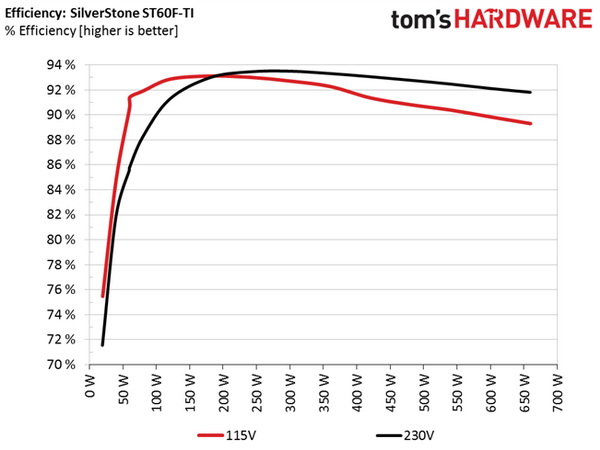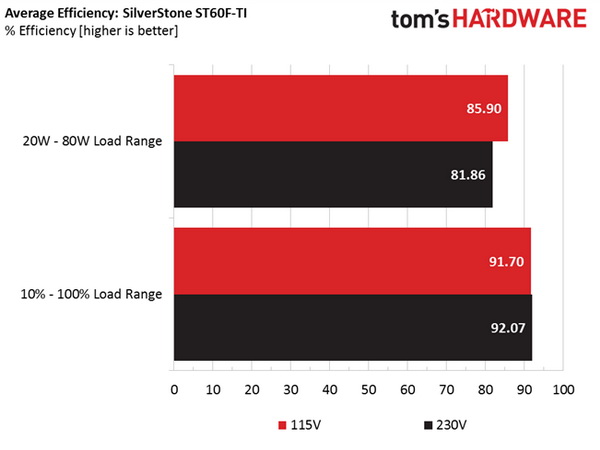SilverStone Strider Titanium ST60F-TI PSU Review
SilverStone released its first Titanium PSU series, which is made by Enhance Electronics. The smallest Strider Titanium unit will be under our scope today. Besides high efficiency it also offers compact dimensions and a fully modular cable design.
Why you can trust Tom's Hardware
Efficiency, Temperature And Noise
Efficiency
Our efficiency testing procedure is detailed here.
Using the previous page's results, we plotted a chart showing the ST60F-TI's efficiency at low loads and loads from 10 to 110 percent of the PSU's maximum-rated capacity.




Under light loads (<170W), efficiency is significantly higher with 115V input.
Efficiency At Low Loads
In the following tests, we measure the efficiency of the ST60F-TI at loads significantly lower than 10 percent of its maximum capacity (the lowest load the 80 PLUS standard measures). The loads we dialed were 20, 40, 60 and 80W. This is important for representing when a PC is idle, with power-saving features turned on.
| Test # | 12V | 5V | 3.3V | 5VSB | DC/AC (Watts) | Efficiency | Fan Speed (RPM) | Fan Noise | PF/AC Volts |
|---|---|---|---|---|---|---|---|---|---|
| 1 | 1.226A | 0.491A | 0.475A | 0.195A | 19.62 | 75.46% | 705 | 26.0 dB(A) | 0.808 |
| 11.894V | 5.018V | 3.360V | 5.012V | 26.00 | 115.1V | ||||
| 2 | 2.477A | 0.990A | 0.982A | 0.396A | 39.72 | 84.82% | 705 | 26.0 dB(A) | 0.894 |
| 11.900V | 5.016V | 3.355V | 5.005V | 46.83 | 115.1V | ||||
| 3 | 3.729A | 1.487A | 1.489A | 4.998A | 59.82 | 91.40% | 705 | 26.0 dB(A) | 0.920 |
| 11.899V | 5.013V | 3.352V | 4.998V | 65.45 | 115.1V | ||||
| 4 | 4.974A | 1.994A | 1.970A | 0.800A | 79.75 | 91.91% | 730 | 26.2 dB(A) | 0.938 |
| 11.897V | 5.010V | 3.348V | 4.991V | 86.77 | 115.1V |
Efficiency is super high under light loads, and the fan's noise is kept at very low levels, as you can see in the table above.
5VSB Efficiency
The ATX specification states that 5VSB standby supply efficiency should be as high as possible, recommending 50 percent or higher efficiency with 100mA of load, 60 percent or higher with 250mA of load and 70 percent or higher with 1A or more of load.
We will take four measurements: one each at 100, 250 and 1000mA, and one with the full load the 5VSB rail can handle.
Get Tom's Hardware's best news and in-depth reviews, straight to your inbox.
| Test # | 5VSB | DC/AC (Watts) | Efficiency | PF/AC Volts |
|---|---|---|---|---|
| 1 | 0.101A | 0.50 | 73.53% | 0.045 |
| 4.936V | 0.68 | 115.1V | ||
| 2 | 0.252A | 1.24 | 77.02% | 0.103 |
| 4.932V | 1.61 | 307.6V | ||
| 3 | 1.002A | 4.92 | 84.25% | 0.274 |
| 4.911V | 5.84 | 115.1V | ||
| 4 | 2.502A | 12.18 | 82.24% | 0.389 |
| 4.868V | 14.81 | 115.1V |


A Titanium-rated PSU ought to have a highly efficient 5VSB rail, and indeed that's the case here. Only FSP's HG650 registers notably higher efficiency than SilverStone's ST60F-TI, by isolating the APFC converter while the PSU is in standby mode.
Power Consumption In Idle And Standby
In the table below, you'll find the power consumption and voltage values of all rails (except -12V) when the PSU is idle (powered on, but without any load on its rails), and the power consumption when the PSU is in standby mode (without any load, at 5VSB).
| Mode | 12V | 5V | 3.3V | 5VSB | Watts | PF/AC Volts |
|---|---|---|---|---|---|---|
| Idle | 11.901V | 5.024V | 3.364V | 5.024V | 7.76 | 0.448 |
| 115.1V | ||||||
| Standby | 0.06 | 0.004 | ||||
| 115.1V |


Phantom power is very low with both 115V and 230V input.
Fan RPM, Delta Temperature And Output Noise
Our mixed noise testing is described in detail here.
The first chart below illustrates the cooling fan's speed (in RPM), and the delta between input and output temperature. The results were obtained at 35 °C (95 °F) to 46 °C (114.8 °F) ambient temperature.
The next chart shows the cooling fan's speed (again, in RPM) and output noise. We measured acoustics from one meter away, inside a small, custom-made anechoic chamber with internals completely covered in sound-proofing material (be quiet! Noise Absorber kit). Background noise inside the chamber was below 18 dB(A) during testing, and the results were obtained with the PSU operating at 35 °C (95 °F) to 46 °C (114.8 °F) ambient temperature.
The following graph illustrates the fan's output noise over the PSU's operating range. The same conditions of the above graph apply to our measurements, though the ambient temperature was between at 28 °C (82.4 °F) to 30 °C (86 °F).
Under normal temperature conditions, SilverStone's Titanium-class ST60F-TI features quiet operation. Even in worst-case scenario, the fan's output stays below 34 dB(A). Despite the lack of a semi-passive mode, this power supply appears ideal for low-noise configurations.
Current page: Efficiency, Temperature And Noise
Prev Page Load Regulation, Hold-Up Time And Inrush Current Next Page Cross-Load Tests And Infrared Images
Aris Mpitziopoulos is a contributing editor at Tom's Hardware, covering PSUs.
-
JamesSneed So essentially this is a overpriced PSU with to much ripple. This left me wondering why the EVGA SuperNova 850 T2 was not in the charts. You mentioned the SuperNova towards the end and it just seems like the proper competitor since its another TI rated PSU.Reply -
Jack_565 Nice to see a review on at least one of the Strider Titanium units.Reply
I recently purchased a 800w Version(these are the only Titanium PSUs in the Australian Market under 1000w) and its been everything i've wanted, running at almost 50% load it gives me its peak efficiency which is exactly why i paid the premium to get a Titanium PSU.
I can see the 600w version being a more commonly purchased unit with the way power consumption has dropped, Skylake Rigs only use around 300w(give or take variables) which would be the Striders peak efficiency. -
turkey3_scratch Jonnyguru also did a review on the same unit here, so the "high" ripple is consistent among these units. Probably due to a lack of filter capacitors, either to increase efficiency or conserve space. I'd like to see how the efficiency would be improved if they used a relay.Reply
What I don't understand is the small transformer. Aris, you mentioned that this unit, to have higher efficiency, switches to not-as-high of a frequency (which also affects transient response negatively). Since transformer size is inversely proportional to the AC frequency, wouldn't the transformer have to be larger? Is there any downside to a smaller transformer?
Yet again, more PWR_OK cheaters. It seems like at least one in two PSUs are like this. I agree that no power switch on this unit seems very silly to me. -
Aris_Mp The switching frequency probably isn't as high in order to achieve the higher possible efficiency, but this doesn't necessary means that it isn't high enough to allow for a small main transformer. In addition the design of the transformer plays a key role also in this.Reply


